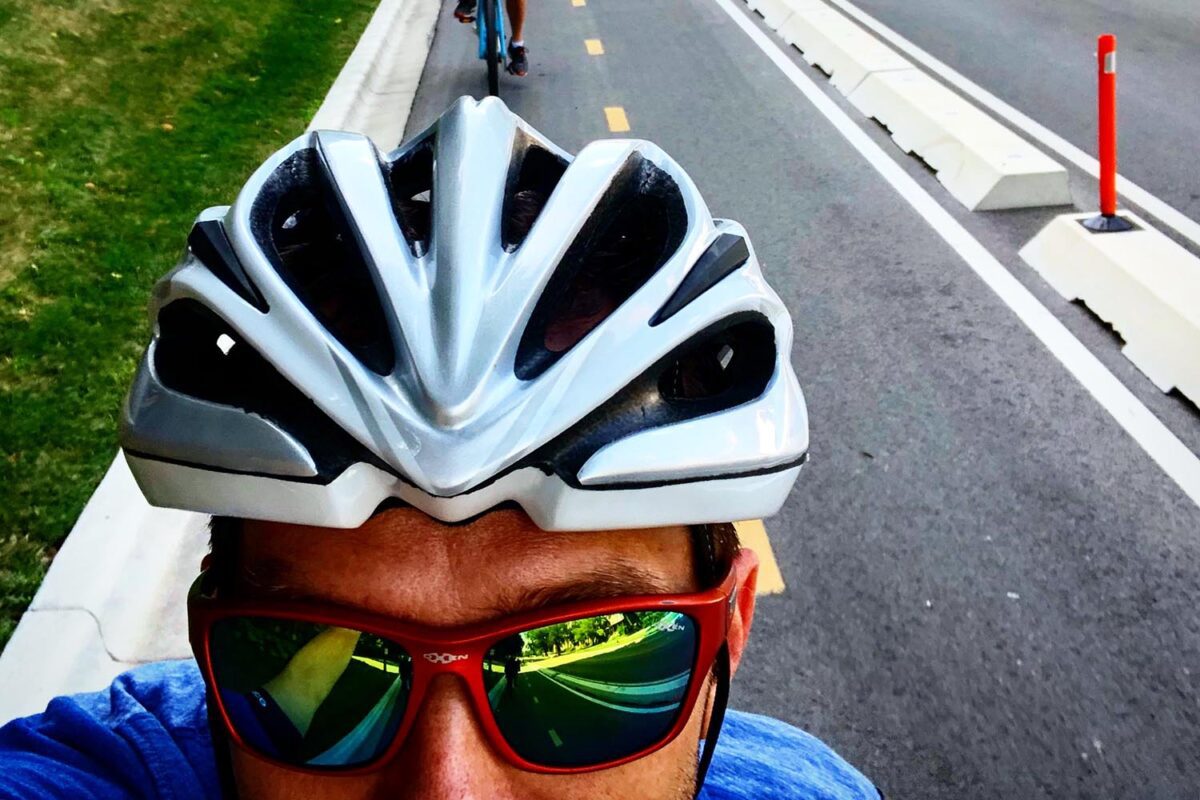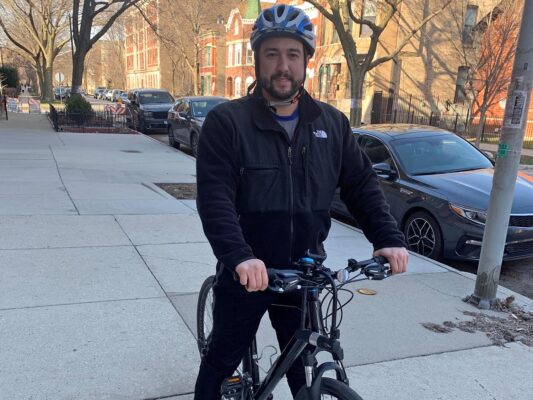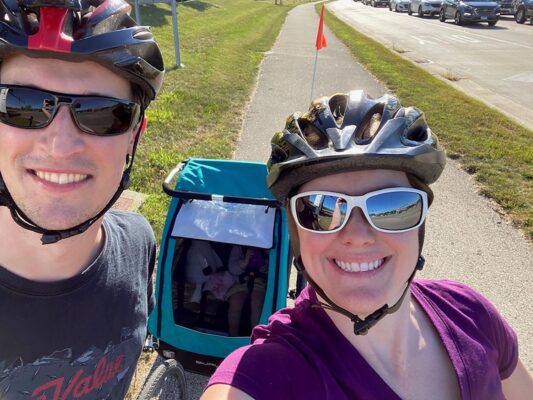
May is National Bike Month! The observance is promoted by the League of American Bicyclists and is celebrated across the U.S. as a way to encourage biking and promote its benefits. Civiltech supports awareness of cyclists sharing our roads and applies a Complete Streets approach to all of our roadway projects. We strive to provide well-designed bike infrastructure that allows cyclists and drivers to share the road safely.
With many avid cyclists on staff, the Civiltech team not only promotes biking, we also “walk the walk” (or should we say, “bike-the-bike?”). Civiltech’s Louis Pukelis, P.E.; Amanda Kleinwachter, P.E.; and Phil Hutchinson, PLA, LEED AP, shared insights on how their love of biking impacts their approach to bike facility design work.
Louis is a Traffic Engineer and biking enthusiast who lives in the City. Even though he has a car, his bike is his primary mode of transportation within the City when the weather is dry and not too cold. Louis enjoys using his bike to commute to work, meet up with friends, run errands, work out, and even to get to Cubs games! He enjoys utilizing Chicago’s bike trails, like the 606 and the Lakefront Trail, but also rides on city streets favoring routes with bike lanes. 
As a Traffic Engineer, Louis believes that good design of urban on-street bike facilities encourages safer behavior from both bikers and motorists. Bike lanes are an incentive for cyclists to ride where indicated which is safer for the biker and less frustrating to the motorist. Also, Louis shares that riding in a city like Chicago is not for the faint of heart, and many people who would like to ride choose not to. Thus, well-designed biking infrastructure, including highly visible lanes and appropriate traffic signaling, gives novice bikers the encouragement and peace of mind to bike more.
Louis looks forward to the day when U.S. cities are as accessible, safe, and inviting to bike within as European cities. However, he points out that within the U.S., Chicago enjoys a robust mix of transit, bike, and pedestrian facilities and continues to improve its biking infrastructure. As a Civiltech Traffic Engineer, Louis enjoys being part of that work.
Amanda considers herself more of a recreational cyclist and enjoys riding with her family, which includes two little girls, a 1 year old and a 4 year old. While Amanda was an active biker prior to having children, she shares that being a mom has greatly impacted her views on bike infrastructure.
Amanda and her husband lived in the City prior to having children and were comfortable riding in any form of bike lane or shared lane. Once they had children and started including them in their rides by pulling them in a bike trailer, being a defensive cyclist took on whole new meaning with the instinct to protect your children. Amanda states that riding with children adds a higher level of vulnerability, especially when riding in a non-protected bike lane or on the road. She and her family now choose to bike on sidepaths or protected bike lanes, when possible.
In her role at Civiltech, Amanda actively designs urban bicycle and pedestrian facilities, and she explains that her experiences of riding with her children heightened her understanding of the need to design for all users. All bikers have different comfort levels based on age and ability. Amanda states that designing good bike facilities is not just about the physical accommodations, but also is an important tool to help cyclists recognize their vulnerabilities and to encourage safe
and defensive biking.
Amanda recently got to apply her experience both as an avid recreational biker and as a Transportation Engineer in an activist capacity. She currently lives on a county route and had identified the need for a paved shoulder to provide connections to a nearby side path. As part of the Illinois Road and Transportation Builders Association (IRTBA) Emerging Leaders Program, Amanda recently got to meet with County Engineers and was able ask the Engineer for her specific county the hypothetical question of how someone could advocate for a paved shoulder or other bicycle facility on a County Route.
Phil is a Landscape Architect with Civiltech. He lives in the City and commutes almost exclusively by bike. To make bike commuting more convenient, Phil is a Divvy member which removes the obstacle of how to park or store his bike when he reaches his destination and allows for easy one-way bike trips.
At Civiltech, Phil is active in the design of urban bike infrastructure as well as multi-use trails. He brings his biking experience to his design work saying that when he is involved in a project to improve bike infrastructure, he thinks about his own choice to choose a bike over a car and how the infrastructure impacts that ability. 
As a city dweller, Phil advocates for avoiding contributing to traffic and congestion whenever possible. He believes that cities are better with fewer cars, a belief that has been partially forged by his experience traveling in European cities with car-free zones, and that if he is one less car on the road, he’s contributing to this ideal. His advocacy starts at home where he has taught his 1st grade daughter that they should always try to walk, bike, or take transit to their destinations unless they absolutely can’t.
From a design perspective, Phil recognizes that effective bike infrastructure varies depending on location. Tools used in dense urban settings do not always translate to suburban settings. Bike facility design in suburban areas might often be more recreation focused than transportation focused. Design for bike infrastructure outside of urban centers involves a balance of all modes of transportation while respecting the vehicular mobility needed for major roadways with higher speeds and heavier volumes.
But city or suburbs, commuting or recreation,Phil believes it’s important that people have choices and comfortable places to ride. Through his work, he advocates for always keeping the bikes and pedestrians top of mind. Like Amanda, being a parent also shapes his perspective. Phil views the safety of a bike route from the perspective of whether or not he would allow his daughter to bike there.
Much of Phil’s commute utilizes routes with protected bike lanes. As such he appreciates the Chicago Department of Transportation’s (CDOT) efforts to improve bike facilities around the city. He also appreciates CDOT’s equitable approach to improving bike infrastructure with their focus on disadvantaged areas where the ability to commute by bike is critical.
Phil, Amanda, and Louis are grateful that at Civiltech, we have the opportunity to work on projects to improve bike facilities for all users, and clients that recognize the importance of their bike infrastructure.
